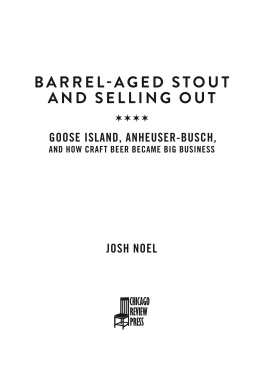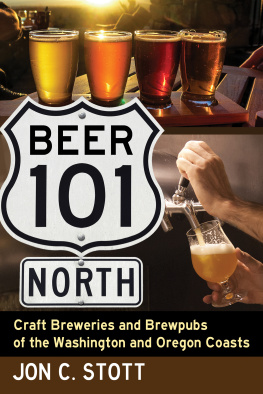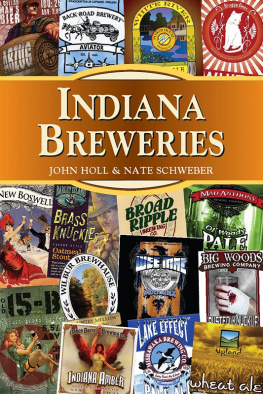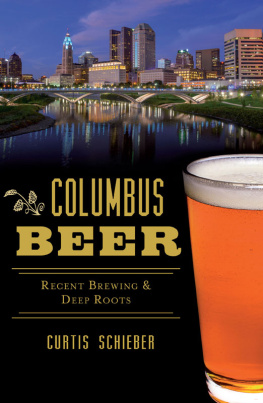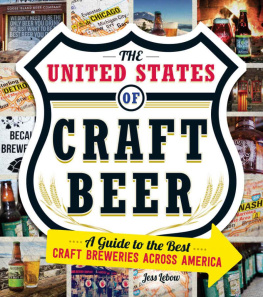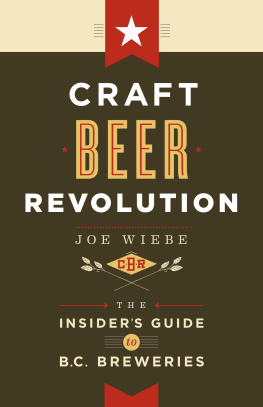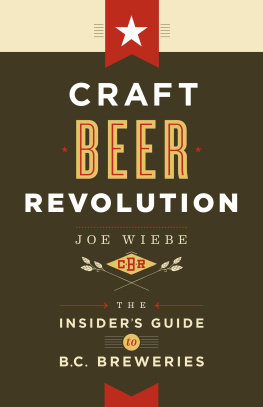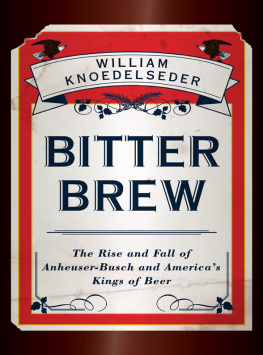Names: Noel, Josh, author.
Title: Barrel-aged stout and selling out : Goose Island, Anheuser-Busch, an
how craft beer became big business / Josh Noel.
Description: First edition. | Chicago, Illinois : Chicago Review Press
[2018] | Includes bibliographical references and index.
Identifiers: LCCN 2017050648 (print) | LCCN 2017054555 (ebook) | ISBN 9781613737224 (adobe pdf) | ISBN 9781613737231 (kindle) | ISBN 9781613737248 (epub) | ISBN 9781613737217 (trade paper)
Subjects: LCSH: Goose Island Brewery. | Anheuser-Busch, Inc. | Bee industryUnited States. | MicrobreweriesUnited States.
Classification: LCC HD9397.U54 (ebook) | LCC HD9397.U54 G6566 2018 (print)
DDC 338.7/663420973dc23
LC record available at https://lccn.loc.gov/2017050648
Prologue
ITS NOVEMBER 2012.
Chicago is unseasonably warm, but the leaves have turned and winter approaches. Its barrel-aged beer season.
Beer lovers have flocked to Chicago for one of the nations signature events: the Festival of Wood and Barrel Aged Beer. FOBAB, to those in the know.
More than sixty breweries from twenty-one states are on hand. They pour 194 beers with colorful names and exotic backstories. Barrel-Aged Snarling Badger, a twice-fermented Berliner Weisse aged in French oak Syrah barrels from a brewery in Idaho. Barrel-Aged Frosted Frog Christmas Ale, a spiced ale from Ohio aged in bourbon barrels. Gnag Reflex, a tart and funky brown ale aged in new oak with cherries from Louisville.
Every beer in the room has spent time in some sort of wood barrel. Bourbon, mostly. But also red wine, white wine, rye whiskey, rum, gin, and virgin oak.
Most breweries are set up at folding tables at the edges of the brick-walled loft, pouring beer in precious two-ounce increments from plastic pitchers. One brewery stands apart, at an elaborate station just inside the entrance. Its tap handles have been drilled into actual barrels to seem as if the beer is flowing straight from the oak. (It is, of course, coming from kegs beyond the barrels.) That brewery is the only one in the room with enough sway, home-court advantage, and budget to construct such an elaborate show: Goose Island Beer Co.
The twenty-four-year-old brewery is a Chicago icon and arguably the reason that so many people stand in the festive, beer-swilling space; back in 1995, Goose Island pioneered the industrys first imperial stout aged in a bourbon barrel. The beer was named Bourbon County Stout. At FOBAB, bourbon barrelaged stout has become an industry touchstone; it flows in all directions throughout the bright, airy loft.
The room is feeling good.
Craft beer is feeling good.
It is still an underdog. But it is ascendant.
Thirty-five years earlier, the nation was home to fewer than ninety breweries. Now, on this November day, there are nearly twenty-five hundred. More than four hundred have opened during the previous year alonemore than one a day. After decades of Big Beers bland dominance, American beer is rife with choice. Diversity. Flavor. And rarely is it more diverse and flavorful than at FOBAB.
At the end of the night, thirty-two awards are given: a top-three in ten different categories, plus the top two overall beers poured that day.
The brewery that wins more than any other? The hometown hero.
Goose Island scores five medals, including the coveted Best of Show for its Cherry Rye Bourbon County Stout, an offshoot of the original forged seventeen years earlier. Its brewpub wins two more awards, which gives Goose Island nearly a quarter of the evenings honorsseven of the thirty-two.
Each time Goose Islands name is called, its brewers hug and slap hands and leap to the stage. Their work is elite. Here is proof.
Applause rises from the tightly packed crowd, punctured with a few hoots and hollers. But there is also a curious sound: a smattering of boos. They come from a handful of guys deep in the throng. Theyre young and lanky and wear T-shirts, hoodies, and baseball caps.
With their third or fourth jeer, I turn to one and ask: Why boo the hometown favorite?
I dont like Anheuser-Busch, he says.
Many breweries tell the story of craft beer in the United States. Sierra Nevada. Boston Beer. Anchor. Bells. New Belgium. Dogfish Head. Stone. Lagunitas.
Only one brewery is the story of craft beer: Goose Island.
John Hall, a former box company executive, launched the brewery in 1988, when there were just two others in Chicago and fewer than two hundred nationally. Goose Island flourished through the 1990s. Then it struggled. It grew more. It struggled more. It innovated. It took risks. It grew still more.
And then it sold out.
Goose Islands sale in 2011 to Anheuser-Busch wasnt just a sale to the biggest beer company in the worldit was a sale to the company that had spent decades thwarting the American beer industry with confusion, trickery, and dullness. To Anheuser-Busch, less choice was less competition. It was more market share. When American beer was nothing but stadium sponsorships and Super Bowl commercials, Anheuser-Busch was able to account for nearly one of every two beers sold in the United States.
Then came craft beer. American beer drinkers discovered variety. Tastes diversified. Anheuser-Busch could no longer simply suffocate competition. It needed craft beer.
So it bought Goose Island.
The announcement of Goose Islands $38.8 million sale to the worlds largest beer company, on March 28, 2011, functionally ended an era for craft beeran era of collaboration and cooperation, growth and good vibes, and the shared cause of building a lifeboat in a sea of Big Beer banality.
Anheuser-Busch and its parent company, Belgian-Brazilian conglomerate Anheuser-Busch InBev, kept buying breweries, and as they did, divisions grew starker and more rancorous. The classic American success storynurturing a business that changed an industry, then selling it for millionsbecame heresy in craft beer.
The beer industry entered an era of revolutionfragmentation, increased competition, and, for the breweries that dared to follow Goose Islands lead with a sale to Anheuser-Busch, searing claims of sellout.
Selling to the worlds largest beer company guaranteed growth for Goose Island and a payday for John Hall. His risk and vision were rewarded. But no matter how good the beer, how many honors or awards, how innovative Goose Island would ever be again, someone deep in the crowd would always boo.
ON A THURSDAY EVENING IN 1986, as a spring storm pounded the DallasFt. Worth airport, John Hall sat in an airplane on the rain-glazed tarmac and did something he would recount for the rest of his life. He reached for a magazine.
John was forty-four and had grown from a low-level sales grunt to one of the senior-most executives at Container Corporation of America, a corrugated box manufacturer housed in a sloping high-rise in downtown Chicago. John had a fine view of the skyline from his fifty-fourth-floor corner office, but he spent much of his time on the road. He was headed home from a few days in Ft. Worth and Houston, visiting two of the plants he managed. But the plane wasnt moving, and the rain wasnt letting up. There was talk of tornadoes. He needed distraction. Tired and ready to be out of his suit, John pulled a magazine from the seatback pocket ahead.

